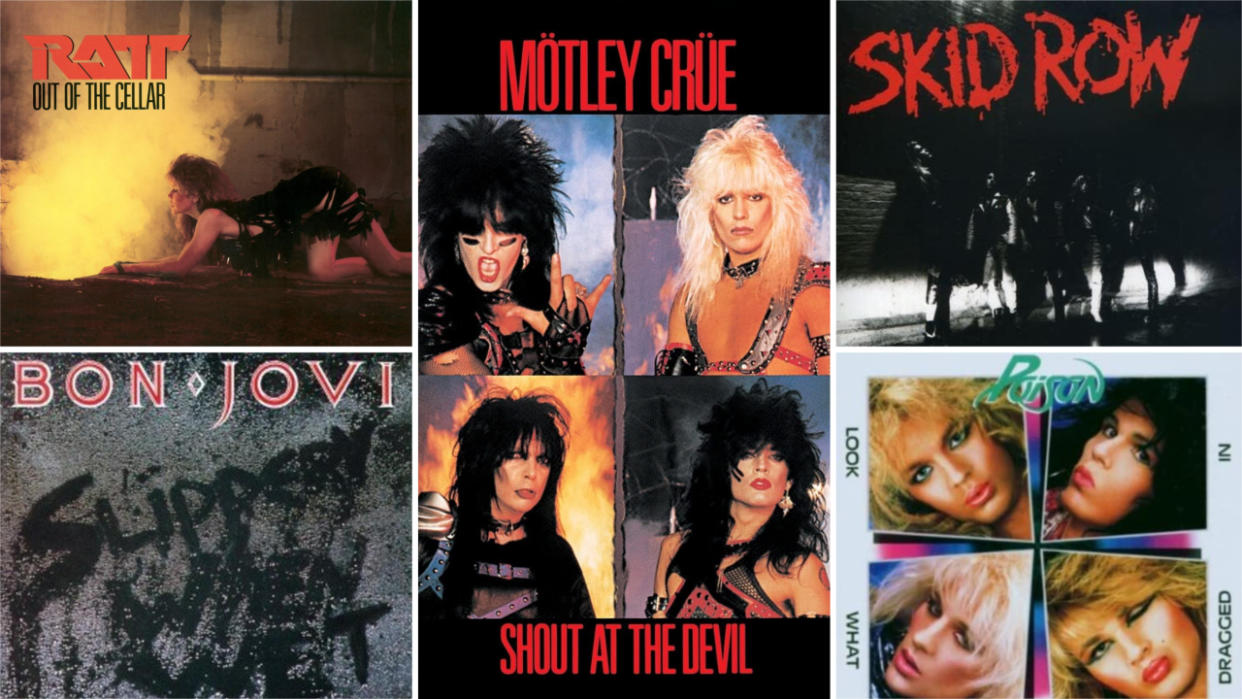A beginner’s guide to hair metal in 5 essential albums

- Oops!Something went wrong.Please try again later.
Let’s get this straight from the start: no one called it hair metal back then. The flashy, flamboyant strain of hard rock that emerged from the Sunset Strip clad in fishnet tops and enveloped in an Aquanet fug was widely known at the time as glam metal. It was grunge’s grumbling malcontents who rechristened it, a dig at the fact it was supposedly about image over content. Yeah, cheers for that, Kurt Cobain. Hair metal it is, then.
Whatever you want to call, it provided the soundtrack to the entire decade, particularly the bits that involved stumbling out of nightclubs with names like The Cathouse and Decadence at 3am, clutching the slops of the 18th Jack Daniel’s and coke of the night.
And that was point of hair metal – after the muso worthiness of the 1970s, it was a breath of fresh air. Fun was at the top of the agenda, closely followed by getting wasted, dating Tawny Kitaen and inadvertently punching a great big hole in the ozone layer via the sheer volume of hairspray involved.
For a few years, every transplanted Wisconsin farmhand with a bit of rouge on their cheeks and lippy on their gobs could bag an MTV hit and a platinum album. Hair metal’s detractors wrote it off as shallow, vacuous pop music in hard rock drag, completely missing the point that it was precisely what it was supposed to be. This was the preening glam of Bolan, Bowie and Sweet superimposed onto the pretend-tough guy posturing of 80s metal, and sounding all the more brilliant for it.
But where to start with this most misunderstood of genres? Well, like that stripper that let you sleep on her couch rent-free for three months in 1987, we’re here to help. You might wonder where Guns N’ Roses’ Appetite For Destruction and Def Leppard’s Hysteria aren’t on this list, but history has proven those albums to be too feral and too polished respectively to be classed as mere hair metal. Ditto Twisted Sister, Quiet Riot, Dokken, Kix – all great bands, but none quite hitting that sweet spot between
Instead, we’ve whittled an entire decade to just five albums. And remember, it literally is nothin’ but a good time.

Mötley Crüe - Shout At The Devil (1983)
Mötley Crüe’s second album, their platinum-selling breakthrough, was an all-out attack on America’s self-appointed moral majority. With its faux-Satanic imagery, a mischievous warning of “masked backwards messages” and a knowingly controversial cover of The Beatles’ Helter Skelter (a song inextricably linked to the 1969 Manson Family murders), Shout At The Devil was an affront to decency.
It was also, fundamentally, a great heavy metal record, stacked with gonzoid anthems: Looks That Kill, Too Young To Fall In Love and the fists-in-the-air title track. The Crüe’s alien-hooker chic – skyscraper hair, crude make-up, S&M leather outfits – spawned a legion of copycat bands on the Sunset Strip. Equally, Shout At The Devil remains the definitive ‘80s glam metal album, and Mötley’s masterpiece.
Ratt - Out Of The Cellar (1984)
Ratt revolved around big-mouth singer Stephen Pearcy, even bigger-mouthed drummer Bobby ‘The Blotz’ Blotzer and the sunny and dumb guitarist Robbin Crosby. They took their cue from Aerosmith and Cheap Trick rather than from contemporaries like Motley Crue, but Ratt were neither as smart nor cool.
What they were tremendously good at was having a good time, and this record sums up their appeal: its best song, Round And Round, is hardly rocket science, but it’s impossible to forget. The cover was a peach, too, featuring the late Tawny Kitaen (then Crosby’s girlfriend and later David Coverdale’s wife) escaping said cellar in her scanties.
Poison - Look What The Cat Dragged In (1986)
Recorded for just $23,000, Look What The Cat Dragged In is an instant, disposable trash metal classic. Intoxicating while it lasts, the record is too flimsy to withstand close examination, yet it perfectly captures its time.
Poison were too pretty to pull off anything other than lightweight sentiments like Talk Dirty To Me and Cry Tough, but they didn’t need to do anything else. They were a cheap date, and by the end of the night you knew you’d had a lot of fun. The subsequent Open Up And Say… Ahh was bigger, but Look What The Cat Dragged In said the same things faster and just as well.
Bon Jovi - Slippery When Wet (1986)
Bouncy of perm and tight of trousers, Bon Jovi’s first two albums were fine enough, but this time mainman Jon Bon Jovi enlisted the pop genius that was Desmond Child, who co-wrote the immortal You Give Love A Bad Name and Livin’ On A Prayer. However, Jon and guitarist also wrote some great stuff without Child: the rock-star-as-outlaw anthem Wanted Dead Or Alive, and crowd-pleaser Raise Your Hands.
Currently ranked as the 34th biggest-selling studio album of all time, with 28 million copies sold worldwide, Slippery When Wet is the hair metal album by which all others must be judged. This was the gateway drug for millions of teenagers – a larger-than-usual proportion of who were girls – into the world of hard rock.
Skid Row – Skid Row (1989)
Skid Row epitomised the latter stages of hair metal. With the blueprint established, their mentor Jon Bon Jovi and manager Doc McGhee simply applied a tried and trusted formula. With a pretty, OTT frontman in Sebastian Bach, they had a man willing to sell his mother for the slightest whiff of fame. And it duly came along with this record.
The rest of the band were seasoned players, so songs like 18 And Life and Youth Gone Wild were immediate and anthemic. Given the material, they knew exactly how to treat it. Bach was living it large, and Skid Row quickly became the rock monster he craved.

